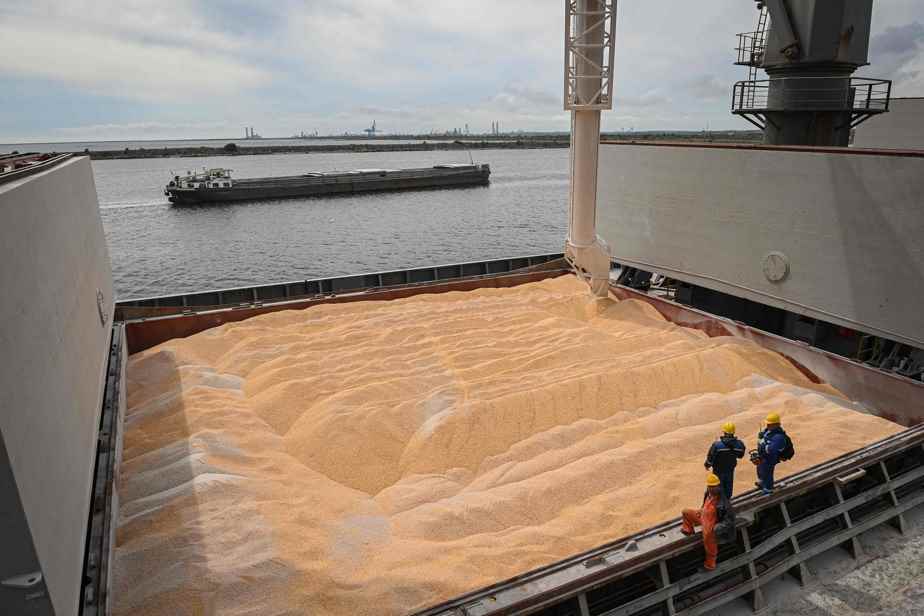(Constanta) Like an enormous elephant’s trunk, the pipe sweeps the ship, spilling tons of corn: the Lady Demine is preparing to leave Constanta, a Romanian port on the Black Sea which has become a rare port of exit for Ukrainian agricultural products.
Posted at 2:33 p.m.
The grain vessel, over 160 meters in length and with a capacity of 26,000 tonnes, is the second in five days to moor at pier number 80 to receive a precious cargo of golden seeds from the neighboring nation, whose ports are blocked by the Russian invader. Destination: Portugal.
The stakes are vital for many countries dependent on deliveries from Ukraine, which before the war exported by sea 4.5 million tonnes of agricultural production per month – 12% of wheat, 15% of corn and 50% sunflower oil worldwide.
The blockade is total, from the Sea of Azov, closed to navigation from the start of the offensive, to the port of Odessa, on the Black Sea, which normally represents 60% of the country’s port activity.
Trains, barges, trucks
Among the alternatives, Romania is an ideal candidate. A member of NATO with secure waters, the country is also the second wheat exporter in the European Union behind France and has adequate infrastructure.
“The departure of a third ship is scheduled in six days and we hope to accelerate the pace,” says Viorel Panait, CEO of Comvex, Constanta’s leading cereal operator.
“Given the unfortunate situation that our Ukrainian neighbors are going through, we must help them as much as we can,” he adds.
But before reaching the port, the grain has a long way to go. They are loaded onto trains, heavy goods vehicles or even barges in the small Danube ports of Reni and Izmaïl, located in the extreme south-west of Ukraine, on the border with Romania.
To fill a 70,000-ton ship such as the one that left Constanta last week for the first time, it takes 49 trains or as many barges, explains Mr. Panait.
Or even thousands of trucks, at the risk of creating a huge traffic jam in the maze of intersecting roads in Constanta. A “puzzle” for Florin Goidea, the port manager.
Pressed to act to modernize an aging railway network, the government has found a solution: to rehabilitate 95 railways dating from the communist era and blocked for years by hundreds of rusty wagons.
“This project, worth 200 million lei (40 million euros), is extremely important, because it will unblock road traffic in the port” and will allow to increase the stocks handled, underlines Mr. Goidea in his office with breathtaking view of the harbor bristling with cranes, ship loaders and other steel structures.
“The war in Ukraine is a challenge, but also an opportunity”, launches the director, specifying that this port has become in 2021 “the European pole for grain exports in front of Le Havre”, in France.
And to hope to beat the record traffic of 67.5 million tonnes recorded that year.
“Risk of starvation”
230 km to the north, another Romanian port could also provide an outlet for Ukrainian exports, that of Galati on the Danube.
It is connected to Moldova by five short kilometers of railway which retain the gauge of the rails used in the former USSR and its satellite countries and which corresponds to that still in service in Ukraine.
The renovation of this line, scheduled for this summer, will make it possible to transport goods without having to change the axles of the wagons, as is the case for other railways.
A complicated maneuver, just like the solution found in extremis by Ukrainian port operators in the case of barges: they currently lift the wagons using cranes to dump the grain.
However, for agricultural products to remain accessible, fast and inexpensive transport is essential, explains the CEO of Comvex. “We need to make sure they get to consumers’ tables without delay to avoid the risk of starvation.”
Along one of the port’s congested roads, dozens of wind turbine masts and rotors destined for Ukraine look abandoned, at the mercy of the elements.
“There is no one left to send them to” in the bomb-stricken country, says an employee.
